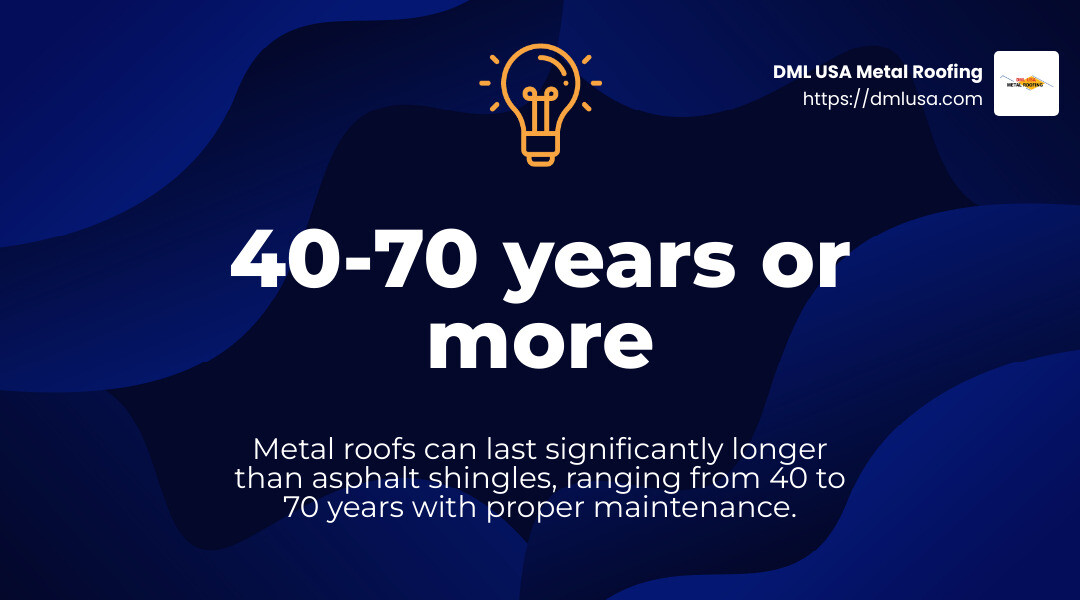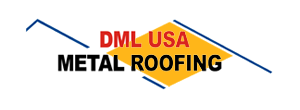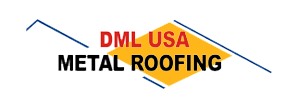What is the cost difference between metal roofing and shingles? In navigating roofing choices, this question becomes pivotal. On average, metal roofs cost more upfront, typically ranging between $4.50 and $16 per square foot, compared to asphalt shingles, which cost between $2 and $8 per square foot. However, the higher initial investment in metal roofing can often translate to significant long-term savings due to its durability and energy efficiency.
When choosing between these two popular roofing options, homeowners must consider their budget, desired longevity, and environmental impact. Metal roofs offer exceptional durability and minimal maintenance, while shingles come at a lower initial cost but may require frequent repairs.
As Adam Kadziola of DML USA Metal Roofing, I’ve spent years understanding roofing costs and options. With expertise in assessing what is the cost difference between metal roofing and shingles, I can guide you through making a decision that aligns with your needs and budget.

What is the Cost Difference Between Metal Roofing and Shingles?
When it comes to roofing, understanding what is the cost difference between metal roofing and shingles is crucial for homeowners. Let’s break down the costs of each option, focusing on upfront costs, material costs, and labor costs.
Metal Roofing Costs
Metal roofing is known for its durability and long lifespan. The upfront costs for metal roofs are higher, ranging from $4.50 to $16 per square foot. This includes both material and installation costs.
Materials: Metal panels, such as aluminum, zinc, and steel, contribute to the higher initial cost. These materials are known for their longevity and resilience against harsh weather conditions.
Installation: Installing metal roofing requires specialized skills. As a result, labor costs can be higher compared to shingles. The complexity of the installation process, especially on roofs with steep pitches or many angles, can add to the expense.
Durability: Metal roofs can last between 40 to 70 years, or even longer with proper maintenance. This durability often justifies the higher initial investment, as homeowners save on repair and replacement costs over time.

Asphalt Shingles Costs
Asphalt shingles are a popular choice due to their affordability. The cost for asphalt shingles typically ranges from $2 to $8 per square foot.
Affordability: The lower material and installation costs make asphalt shingles an attractive option for budget-conscious homeowners. They are easier to install, which can reduce labor expenses.
Materials: Asphalt shingles are made from a combination of asphalt and fiberglass, which makes them less expensive but also less durable than metal roofing.
Lifespan: Asphalt shingles generally last between 15 to 30 years. While they are cheaper upfront, they may require more frequent replacements and repairs, especially in areas prone to severe weather conditions.
In summary, while metal roofing costs more upfront, it offers long-term savings due to its durability and low maintenance needs. Asphalt shingles, on the other hand, provide a more affordable initial option but may lead to higher costs over time due to their shorter lifespan and maintenance requirements.
Factors Influencing Roofing Costs
When planning a roof replacement, understanding the factors that influence the cost is essential. Let’s explore how roof square footage, accessibility, and complexity affect the overall expense.
Roof Square Footage
The size of your roof is the most straightforward factor in determining costs. Roof square footage directly impacts the amount of materials required and the labor involved.
Materials: All roofing materials are priced per square foot, so a larger roof means more material is needed. Whether you choose metal or asphalt shingles, expect costs to rise with increased square footage.
Labor and Time: A bigger roof requires more time to cover, which increases labor costs. More workers might also be needed to complete the job efficiently.
Roof Accessibility
How easily roofers can access your roof significantly affects the cost of installation.
Landscaping and Obstacles: Features like gardens, patios, or fences can make it challenging for contractors to access the roof. This can lead to increased labor costs, as workers need more time to steer around these obstacles.
Distance to Materials: If the materials and tools are far from the roof, it adds to the time and effort needed, further increasing labor costs.
Roof Complexity
The complexity of your roof design also plays a crucial role in the cost of replacement.
Facets and Angles: Roofs with multiple facets and angles, like those with dormers or multiple peaks, require more precision and time, leading to higher labor costs.
Penetrations: The presence of chimneys, skylights, or vents (known as roof penetrations) increases the complexity. Each penetration requires careful flashing to prevent leaks, adding to the material and labor expenses.
In conclusion, the combination of roof square footage, accessibility, and complexity can significantly influence the overall cost of a roofing project. Understanding these factors can help homeowners make informed decisions and budget more effectively for their new roof.
Long-term Value and Maintenance
When choosing between metal roofing and asphalt shingles, it’s crucial to consider not just the initial costs but also the long-term value and maintenance. Let’s explore the durability, maintenance needs, and energy efficiency of both options to help you make an informed decision.
Metal Roof Longevity
Metal roofs are known for their impressive durability and longevity. They can last anywhere from 40 to 70 years, sometimes even longer with proper care. This makes them an excellent long-term investment for homeowners planning to stay in their homes for decades.
Durability: Metal roofs are highly resistant to fire, lightning, and extreme weather conditions like snow and hail. They can withstand winds up to 120 mph, making them a reliable choice in storm-prone areas.
Maintenance-Free: Once installed, metal roofs require minimal maintenance. Occasional inspections and cleanings are usually sufficient to keep them in top condition.
Energy Efficiency: Metal roofs reflect heat, reducing heat transmission into the home. This can lead to significant energy savings, with potential reductions in cooling costs by up to 40%.

Shingle Roof Maintenance
Shingle roofs, typically made from asphalt, offer a more affordable upfront cost but come with certain maintenance considerations. They generally last between 15 to 30 years and may require more frequent attention.
Repairs and Replacement Frequency: Shingle roofs are more susceptible to weather damage, including high winds, storms, and pests. This means they often need regular repairs and, over time, complete replacements. Homeowners should expect to replace shingles every 15 to 20 years, depending on the local climate and weather conditions.
Weather Damage: Shingles can be vulnerable to humidity and moisture, which may lead to issues like mold and rot. Regular inspections and timely repairs are necessary to prevent long-term damage.
Energy Efficiency: Shingles tend to absorb heat, which can increase cooling costs during hot months. While they offer medium energy efficiency, they don’t match the savings potential of metal roofs.
In summary, while metal roofing involves higher initial costs, its long lifespan, low maintenance needs, and energy efficiency make it a compelling choice for long-term value. On the other hand, asphalt shingle roofs offer affordability upfront but may incur more frequent maintenance and replacement expenses over time. Understanding these differences can help you choose the best roofing option for your home and budget.
Frequently Asked Questions about Roofing Costs
What are the Pros and Cons of Metal Roofs vs. Shingles?
Durability: Metal roofs are incredibly durable, often lasting 40 to 70 years, and can withstand harsh weather conditions like hail and high winds. In contrast, asphalt shingles typically last 15 to 30 years and are more prone to damage from severe weather.
Aesthetics: Both metal roofs and shingles offer a variety of styles and colors. Metal can give a modern look, while shingles are often chosen for a traditional appearance. However, both materials can mimic other styles, allowing you to achieve your desired look.
Environmental Impact: Metal roofs are made from recyclable materials and can be recycled again, making them a sustainable choice. Shingles, however, are petroleum-based and not recyclable, which can contribute to landfill waste.
How Does Roof Pitch Affect Costs?
Steepness: A steep roof pitch can significantly increase roofing costs. This is because steeper roofs require more safety measures and time, increasing labor expenses.
Labor and Safety: Working on steep roofs is more challenging and risky. Roofers need additional safety equipment, like harnesses, to ensure their safety, which can add to the overall cost of installation.
Are Metal Roofs More Energy Efficient?
Reflective Qualities: Metal roofs reflect most of the sun’s rays, reducing heat absorption. This keeps homes cooler in the summer and can lead to energy savings of up to 40%.
Energy Savings: By reflecting heat, metal roofs help lower cooling costs, making them a cost-effective choice in the long run. Shingle roofs, on the other hand, absorb heat, which can increase air conditioning use.
Environmental Benefits: By reducing energy consumption, metal roofs help decrease reliance on fossil fuels, contributing to a lower carbon footprint. This makes them an environmentally friendly roofing option.
Understanding these aspects can guide you in making a well-informed decision about your roofing needs. Up next, we’ll explore more about how these factors influence the overall cost of your roofing project.
Conclusion
Investing in a new roof is a significant decision for any homeowner, and choosing between metal roofing and shingles is a key part of that decision. At DML USA Metal Roofing, we understand the importance of making an informed choice that balances cost, durability, and home value.
Investment in Quality: Opting for a metal roof is an investment in long-term quality. While the initial cost is higher compared to shingles, the benefits are substantial. Metal roofs offer best durability, often lasting 40 to 70 years with minimal maintenance. This longevity means fewer replacements and repairs over time, saving money in the long run.
Boosting Home Value: A metal roof can significantly improve your home’s value. Its resilience against harsh weather conditions, such as hail and high winds, is a major selling point for potential buyers. Additionally, the energy efficiency of metal roofing—reflecting sunlight and reducing cooling costs—translates into financial savings and environmental benefits, which are attractive features in today’s market.
DML USA Metal Roofing Advantage: Based in Illinois, we specialize in manufacturing high-quality, affordable metal roofing products designed to withstand the toughest conditions. Our roofs not only provide energy tax credits but also offer high resistance to fire, wind, and impact. With our innovative products, you can enjoy peace of mind knowing that your investment is protected for decades.
Choosing a metal roof from DML USA is not just about purchasing a product—it’s about making a smart, long-term investment in your home. Whether you’re planning to stay in your house for years to come or considering future resale, a metal roof promises lasting value and peace of mind.
For more details on our products and to explore how a metal roof can benefit your home, visit our product page.

